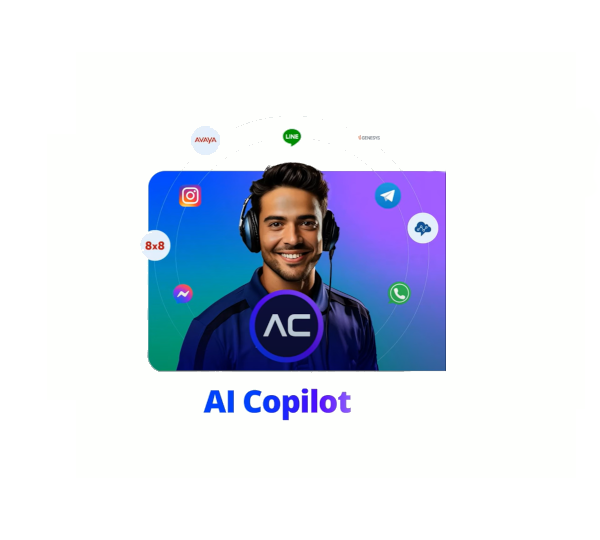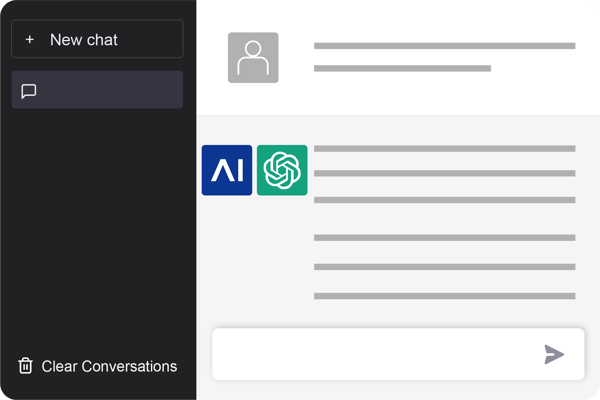In the rapidly evolving landscape of artificial intelligence (AI), the rise of large language models (LLMs) has garnered significant attention in the past months. These models, powered by machine learning algorithms, can generate human-like text, opening a world of possibilities across every walk of life.
Two recent advancements in this field are particularly noteworthy: Prompt Chaining and Multi-Model LLM Orchestration. In this blog, we will take a closer look at their implications through the lens of Conversational AI and customer service automation.
Prompt Chaining: Design Dynamic and Lifelike Conversations
Prompt Chaining is a technique that allows multiple generative prompts to be chained together, so the output of a previous prompt can serve as input for the next one to create more seamless and contextual experiences. This is made possible through visual programming tools, which enable the chaining of LLM prompts into an application, primarily a conversational UI.
The concept of Prompt Chaining is rooted in the versatility of LLMs. These models often produce different answer outputs to the same prompt input, which poses both a challenge and an opportunity. The challenge lies in managing the unpredictable nature of LLMs, as unwanted data can disseminate throughout the chains. However, the opportunity lies in the ability to adapt prompts at runtime by dynamically incorporating customer input to generate responses without requiring prior model training.
Example in Conversation Design
Using Conversational AI as the orchestration platform empowers you to better control and mitigate the risk of LLM randomness within the confines of your business context. Prompt chaining can be seamlessly integrated into the low-code CAI flow builder to let you design advanced conversational experiences with unparalleled flexibility.
For example, you can use the first prompt to analyze and classify customer sentiment. When negative, a second prompt can be triggered to generate an empathetic response before escalating the conversation to an agent. When neutral or positive, the bot can proceed with self-service by using a third prompt to extract required entities and retrieve data from the CRM. Another prompt can then be employed to summarize the retrieved customer data. The possibilities are endless.

Multi-Model Orchestration: Optimal and Future-Proof LLM Deployment
While Prompt Chaining enhances the conversational flow, Multi-Model LLM Orchestration takes it a step further by allowing the configuration of multiple large language models in a virtual agent. Each model can be used for the purpose it’s best suited for, depending on speed, cost, and quality of responses for a given use case.
When pre-integrated into a CAI platform, this capability makes it easy to leverage the strengths of different models and allows you to reap tremendous benefits like:
- UX and Cost Optimization: Using the right model for the right task ensures that the virtual agent delivers the best possible response in every situation while improving the efficiency and cost-effectiveness of the LLM solution.
- Future-Proof Deployment: A robust LLM Orchestration tool grants easy access to existing and future best-of-breed Generative AI models. It also allows for custom integration with any hosted LLMs. As such, you can quickly pivot and migrate to new solutions as the business and market landscapes evolve.
- Unlocking new Capabilities Beyond Prompting: LLMs are capable of more than just prompting and question answering. With LLM Orchestration, you can tap into advanced capabilities like knowledge retrieval from existing enterprise resources and databases to provide the most accurate and reliable responses to customer queries.
- Advanced LLM Ops: A powerful LLM orchestration tool allows you to measure critical performance metrics like latencies and set up automatic model fallback based on unavailability and timeouts. It also enables advanced uptime configuration to help you stay on top of SLA delivery.

Making Generative AI Accessible and Enterprise-Ready
By embedding Prompt Chaining and Multi-Model LLM Orchestration capabilities directly into our low-code CAI platform, Cognigy.AI is democratizing advanced Generative AI for any enterprise user. Through native Generative AI integrations, we already provide seamless access to a variety of best-in-class LLMs on the market, including OpenAI GPT, Azure OpenAI GPT, Anthropic Claude, and Aleph Alpha, among others.
Within the Cognigy.AI interface, you can easily configure your preferred models and select on a granular level which model to use for each specific task – from the automated generation of training data, flow, and output variations to AI-enhanced answering, GPT prompts, and GPT-powered conversations.

Combining with the Flow Editor, you can flexibly customize and chain multiple generative prompts together at any part of the conversation flow. The Cognigy interface enables granular implementation of control measures and data transformation at every step of the authoring process, ensuring your virtual agents are fully mission-focused and high-performing.
Conversational AI and Generative AI: A Match Made in Heaven
The advancements in Prompt Chaining and Multi-Model LLM Orchestration are part of a broader trend in the field of Generative AI. For enterprises, this technology is revolutionizing the way customers engage with brands. It's not just about creating chatbots that can answer basic customer queries, but about building intelligent virtual agents that can understand context, learn from interactions, and deliver frictionless and lifelike experiences never before possible.
Marrying Conversational AI with Generative AI can unleash boundless opportunities for businesses of all sizes, enabling them to deliver superior customer service, streamline internal processes, and drive innovation.
Try it out with Cognigy.AI today!

.png?width=60&height=60&name=AI%20Copilot%20logo%20(mega%20menu).png)




.png?width=600&height=600&name=Knowledge%20AI%20Feature%20image%20(2).png)














